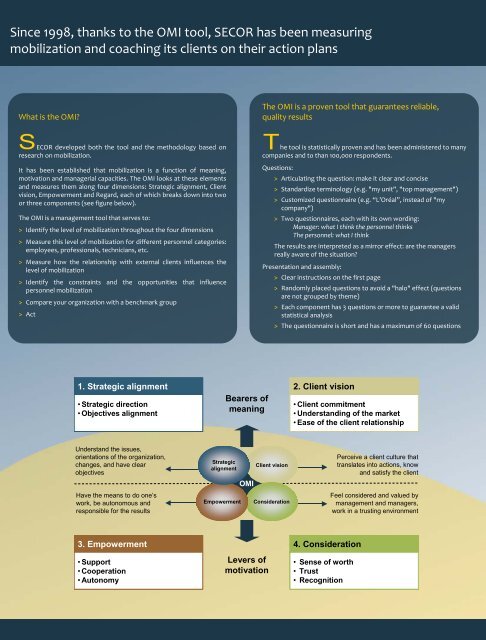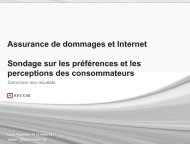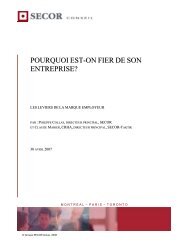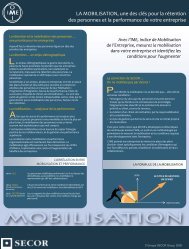La mobilisation du personnel - secor
La mobilisation du personnel - secor
La mobilisation du personnel - secor
Create successful ePaper yourself
Turn your PDF publications into a flip-book with our unique Google optimized e-Paper software.
Since 1998, thanks to the OMI tool, SECOR has been measuring<br />
mobilization and coaching its clients on their action plans<br />
What is the OMI?<br />
The OMI is a proven tool that guarantees reliable,<br />
quality results<br />
ECOR developed both the tool and the methodology based on<br />
research on mobilization.<br />
It has been established that mobilization is a function of meaning,<br />
motivation and managerial capacities. The OMI looks at these elements<br />
and measures them along four dimensions: Strategic alignment, Client<br />
vision, Empowerment and Regard, each of which breaks down into two<br />
or three components (see figure below).<br />
The OMI is a management tool that serves to:<br />
> Identify the level of mobilization throughout the four dimensions<br />
> Measure this level of mobilization for different <strong>personnel</strong> categories:<br />
employees, professionals, technicians, etc.<br />
> Measure how the relationship with external clients influences the<br />
level of mobilization<br />
> Identify the constraints and the opportunities that influence<br />
<strong>personnel</strong> mobilization<br />
> Compare your organization with a benchmark group<br />
> Act<br />
he tool is statistically proven and has been administered to many<br />
companies and to than 100,000 respondents.<br />
Questions:<br />
> Articulating the question: make it clear and concise<br />
> Standardize terminology (e.g. "my unit", "top management")<br />
> Customized questionnaire (e.g. “L’Oréal”, instead of "my<br />
company")<br />
> Two questionnaires, each with its own wording:<br />
Manager: what I think the <strong>personnel</strong> thinks<br />
The <strong>personnel</strong>: what I think<br />
The results are interpreted as a mirror effect: are the managers<br />
really aware of the situation?<br />
Presentation and assembly:<br />
> Clear instructions on the first page<br />
> Randomly placed questions to avoid a "halo" effect (questions<br />
are not grouped by theme)<br />
> Each component has 3 questions or more to guarantee a valid<br />
statistical analysis<br />
> The questionnaire is short and has a maximum of 60 questions<br />
1. Strategic alignment<br />
• Strategic direction<br />
• Objectives alignment<br />
Bearers of<br />
meaning<br />
2. Client vision<br />
• Client commitment<br />
• Understanding of the market<br />
• Ease of the client relationship<br />
Understand the issues,<br />
orientations of the organization,<br />
changes, and have clear<br />
objectives<br />
Have the means to do one’s<br />
work, be autonomous and<br />
responsible for the results<br />
Strategic<br />
alignment<br />
Empowerment<br />
OMI<br />
Client vision<br />
Consideration<br />
Perceive a client culture that<br />
translates into actions, know<br />
and satisfy the client<br />
Feel considered and valued by<br />
management and managers,<br />
work in a trusting environment<br />
3. Empowerment<br />
• Support<br />
• Cooperation<br />
• Autonomy<br />
Levers of<br />
motivation<br />
4. Consideration<br />
• Sense of worth<br />
• Trust<br />
• Recognition





